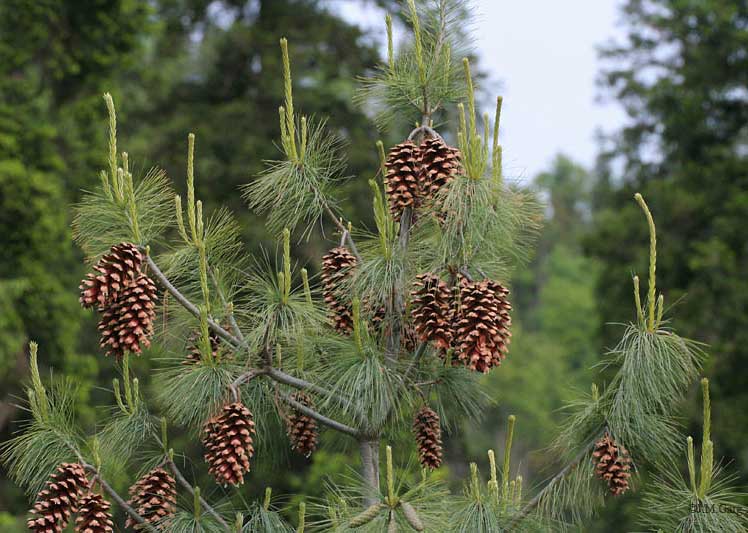
Pinus wallichiana (*)
Superregnum: Eukaryota
Regnum: Plantae
Divisio: Tracheophyta
Divisio: Pinophyta
Classis: Pinopsida
Ordo: Pinales
Familia: Pinaceae
Genus: Pinus
Subgenus: P. subg. Strobus
Sectio: P. sect. Quinquefoliae
Subsectio: P. subsect. Strobus
Species: Pinus wallichiana
Name
Pinus wallichiana A.B.Jacks.
Synonyms
Pinus excelsa Wall. ex D.Don, non Lam.
Pinus griffithii McLell., non Parl.
Pinus nepalensis Chambray, non J.Forbes
References
Bulletin of miscellaneous information / Royal Botanic Gardens, Kew 1938: 85 (1938).
Richardson, D. M. (ed.). (1998). Ecology and Biogeography of Pinus. Cambridge University Press.
Vernacular names
català: Pi de l'Himàlaia
čeština: Borovice himálajská
dansk: Tåre-Fyr
Deutsch: Tränen-Kiefer
English: Blue Pine
Esperanto: Valiĥ-pino
español: Pino llorón del Himalaya
eesti: Pisarmänd
suomi: Kyynelmänty
français: Pin de l'Himalaya
magyar: Himalájai selyemfenyő
íslenska: Himalajafura
македонски: Хималајски бор
polski: Sosna himalajska
русский: Сосна гималайская
Türkçe: Ağlayan çam
Tiếng Việt: Thông trắng Himalaya
中文: 乔松
Pinus wallichiana is a coniferous evergreen tree native to the Himalaya, Karakoram and Hindu Kush mountains, from eastern Afghanistan east across northern Pakistan and north west India to Yunnan in southwest China. It grows in mountain valleys at altitudes of 1800–4300 m (rarely as low as 1200 m), reaching 30–50 m (98–164 ft) in height. It favours a temperate climate with dry winters and wet summers. In Pashto, it is known as Nishtar.[2]
This tree is often known as Bhutan pine,[3] (not to be confused with the recently described Bhutan white pine, Pinus bhutanica, a closely related species). Other names include blue pine,[3] Himalayan pine[3] and Himalayan white pine.[3]
Description
The leaves ("needles") are in fascicles (bundles) of five and are 12–18 cm long. They are noted for being flexible along their length, and often droop gracefully. The cones are long and slender, 16–32 cm, yellow-buff when mature, with thin scales; the seeds are 5–6 mm long with a 20–30 mm wing.
Typical habitats are mountain screes and glacier forelands, but it will also form old-growth forests as the primary species or in mixed forests with deodar, birch, spruce, and fir. In some places it reaches the tree line.[citation needed]
P. wallichiana is the primary host for Himalayan dwarf mistletoe.[4]
Uses
The wood is moderately hard, durable and highly resinous. It is a good firewood but gives off a pungent resinous smoke. It is a commercial source of turpentine which is superior quality than that of P. roxburghii but is not produced so freely.
The tree became available through the European nursery trade in 1836, nine years after the Danish botanist Nathaniel Wallich first introduced seeds to England. It is a popular tree for planting in parks and large gardens, grown for its attractive foliage and large, decorative cones. It is also valued for its relatively high resistance to air pollution, tolerating this better than some other conifers.
This plant[5] and its slow-growing cultivar 'Nana'[6] have gained the Royal Horticultural Society's Award of Garden Merit.[7]
References
Farjon, A. (2013). "Pinus wallichiana". IUCN Red List of Threatened Species. 2013: e.T42427A2979371. doi:10.2305/IUCN.UK.2013-1.RLTS.T42427A2979371.en. Retrieved 19 November 2021.
"نښتر - Wiktionary". en.wiktionary.org. Retrieved 2018-03-29.
"Pinus wallichiana A. B. Jacks". Germplasm Resources Information Network (GRIN). Agricultural Research Service (ARS), United States Department of Agriculture (USDA). Retrieved 23 April 2014.
Hawksworth, Frank G.; Wiens, Delbert (April 1998). Dwarf Mistletoes. DIANE Publishing. pp. 264–265. ISBN 978-0-7881-4201-7. Retrieved 16 April 2022.
"Pinus wallichiana AGM". Royal Horticultural Society. Retrieved 7 May 2020.
"RHS Plantfinder - Pinus wallichiana 'Nana'". Retrieved 25 April 2018.
"AGM Plants - Ornamental" (PDF). Royal Horticultural Society. July 2017. p. 78. Retrieved 2 May 2018.
Retrieved from "http://en.wikipedia.org/"
All text is available under the terms of the GNU Free Documentation License

